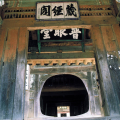HAEINSA TEMPLE
Flagship temple of the Jogye order, one of the country's three largest temples, with halls, national treasures and thirteen hermitages.
This flagship temple of the Jogye order is one of the country's three largest (along with Tongdosa and Sanggwonsa), but also its most renowned. Built in 802 by the monks Suneung and Iljung, it is home to a number of national treasures, each more charming and magnificent than the last. Located in the heart of Gayasan National Park, Haeinsa Temple offers nature and serenity, as well as an incredible wealth of culture and history. It's the ideal temple for those who want to experience the "temple stay" program and immerse themselves in the life of the monks. But the temple's fame is mainly due to the fact that it houses the Triptaka Koreana.
This is a collection of Buddhist texts comprising 80,000 engraved wooden plates measuring 68 cm wide, 24.5 cm long and 3 cm thick. Dating from the end of the Goryeo dynasty, between 1237 and 1248, they were written to ask Buddha for help against the Mongol invasion. They represent a perfect mastery of execution techniques as well as impressive durability. The process used to achieve optimum preservation was as follows: the birch wood used was soaked in seawater for 3 years, then boiled in seawater again. The wood was then polished and calligraphed with no fewer than 52,382,960 ideograms, all of them extremely accurate. National treasure number 32, listed as a Unesco World Heritage site in 1995, is preserved in the two Janggyeong Panjeon buildings high above the temple. Unfortunately, you can't get too close for obvious conservation reasons.
There arenumerous hermitages (13 in all) worth visiting for their scenery and history. Lost in the mountains along streams, they exude a mystical atmosphere during evening prayers (around 5 or 6 o'clock) when wooden gongs echo up the mountain. Set off on a fascinating voyage of discovery.
Visit Geumseon-am and Samseon-am, to the left of the temple. You can even ask for hospitality at these hermitages, which welcome pilgrims. There is also a small wooden bridge on the way to the temple, which is too narrow for a horse. Legend has it that this was to prevent Joseon Confucians from passing through, as they used to enter the temples, and sometimes even the halls, on their mounts.
Did you know? This review was written by our professional authors.
Members' reviews on HAEINSA TEMPLE
The ratings and reviews below reflect the subjective opinions of members and not the opinion of The Little Witty.






In terms of history, this temple has been around for well over 1000 years and some of the buildings are quite old. Most importantly it contains the Tripitaka Koreana, a set of nearly 800 year old wooden blocks containing Buddhist scriptures that have miraculously survived multiple Japanese invasions, the Korean War, and the ravages of time and nature. Few temples in Korea compare to Haeinsa in terms of history.
Aside from the historical elements, aesthetically the temple is quite stunning. It is well laid-out and the buildings are beautiful. The backdrop of Gayasan National Park (a criminally underrated and under-visited national park) makes it even more beautiful.
Admittedly this temple is pretty remote (although there are express buses that run here and back from Daegu West Bus Station), which is probably why it doesn't get the attention it deserves. But this place was amazing and I would highly recommend visiting it.